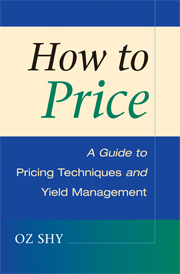Book contents
- Frontmatter
- Contents
- Preface
- 1 Introduction to Pricing Techniques
- 2 Demand and Cost
- 3 Basic Pricing Techniques
- 4 Bundling and Tying
- 5 Multipart Tariff
- 6 Peak-load Pricing
- 7 Advance Booking
- 8 Refund Strategies
- 9 Overbooking
- 10 Quality, Loyalty, Auctions, and Advertising
- 11 Tariff-choice Biases and Warranties
- 12 Instructor and Solution Manual
- References
- Index
10 - Quality, Loyalty, Auctions, and Advertising
Published online by Cambridge University Press: 06 July 2010
- Frontmatter
- Contents
- Preface
- 1 Introduction to Pricing Techniques
- 2 Demand and Cost
- 3 Basic Pricing Techniques
- 4 Bundling and Tying
- 5 Multipart Tariff
- 6 Peak-load Pricing
- 7 Advance Booking
- 8 Refund Strategies
- 9 Overbooking
- 10 Quality, Loyalty, Auctions, and Advertising
- 11 Tariff-choice Biases and Warranties
- 12 Instructor and Solution Manual
- References
- Index
Summary
This chapter analyzes some additional pricing techniques and marketing tactics intended to further enhance sellers' profits. Section 10.1 links pricing decisions to innovation and product design decisions by computing the profit-maximizing quality levels and service classes to be introduced into the market. The underlining assumption in this analysis is that sellers cannot directly price discriminate among the different consumer groups. Therefore, the seller must devise a price scheme under which consumers belonging to different consumer groups choose to purchase different quality levels.
Section 10.2 examines a special case of the above problem by analyzing markets in which the seller may find it profitable to sell a “damaged good” (such as a version containing less features) to consumers with low willingness to pay, to segment the market between consumers with high and low willingness to pay. The interesting feature of this result is that the low-quality product is more costly to produce than the high-quality product. In the case of a service, the low-quality service is more costly to deliver than the original undamaged high-quality service.
Section 10.3.1 analyzes repeatedly purchased services and identifies the conditions under which a firm should provide a discount to its returning “loyal” consumers, and also the conditions for the polar case under which the firm should discount the price for consumers who switch from competing brands. Section 10.3.2 explores the consequences of having sellers commit to matching the prices offered by competing sellers, and demonstrates why this strategy can be profit enhancing.
- Type
- Chapter
- Information
- How to PriceA Guide to Pricing Techniques and Yield Management, pp. 325 - 358Publisher: Cambridge University PressPrint publication year: 2008



